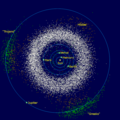Ephemeris
Media related to January 0
| << | January 2024 | >> | ||||
| Sun | Mon | Tue | Wed | Thu | Fri | Sat |
| 1 | 2 | 3 | 4 | 5 | 6 | |
| 7 | 8 | 9 | 10 | 11 | 12 | 13 |
| 14 | 15 | 16 | 17 | 18 | 19 | 20 |
| 21 | 22 | 23 | 24 | 25 | 26 | 27 |
| 28 | 29 | 30 | 31 | |||
| MMXXIV | ||||||
| January in recent years |
| January 2024 |
| January 2023 |
| January 2022 |
| January 2021 |
| January 2020 |
| January 2019 |
| January 2018 |
January 0 refers to the day before January 1 in an annual ephemeris, which is a table of values of dates relating them to objects in the sky. It keeps the date in the year for which the ephemeris was published, thus avoiding any reference to the previous year, even though it is the same day as December 31 of the previous year. In a similar way the pseudodate March 0, used in the Doomsday rule, refers to the day before March 1, keeping it in March without mentioning that it is the last day of February. January 0 occurs in the epoch for the ephemeris second, "1900 January 0 at 12 hours ephemeris time". This is also the epoch used by Newcomb's Tables of the Sun, which became the epoch for the Dublin Julian day. In Microsoft Excel, the day 0 of the 1900 date format is 1900-01-00.
General
[edit]-
Deuxième photographie d'un navisphère, instrument destiné à la préparation d'une observation astronomique (une observation "astro" consiste à mesurer la hauteur angulaire d'un astre au-dessus de l'horizon)en vue de calculer un point astronomique (latitude, longitude). La durée pendant laquelle on peut observer à la fois l'horizon et les astres est très courte (4 à 5 minutes) lors de l'aube et du crépuscule. Aussi, il convient de savoir où les astres que l'on va observer se situent dans le ciel. Le navisphère sert à cela, on le cale à l'aide de la date d'observation et de données issues des "éphémérides nautiques" ou "connaissance des temps".
-
English: The inner Solar System, from the Sun to Jupiter. Also includes the asteroid belt (the white donut-shaped cloud), the Hildas (the orange "triangle" just inside the orbit of Jupiter), the Jupiter trojans (green), and the near-Earth asteroids. The group that leads Jupiter are called the "Greeks" and the trailing group are called the "Trojans" (Murray and Dermott, Solar System Dynamics, pg. 107)
This image is based on data found in the en:JPL DE-405 ephemeris, and the en:Minor Planet Center database of asteroids (etc) published 2006 Jul 6. -
Deutsch: Wird die Länge des tropischen Jahres definiert als das Zeitintervall, welches die Sonne zur Rückkehr zum selben Punkt auf ihrer scheinbaren jährlichen Bahn benötigt, so hängt die Jahreslänge von der Wahl des Startpunkts ab und weist eine merkliche Schwankung mit einer Periode von etwa 21000 Jahren auf. Die moderne Definition wird von der momentanen Änderungsgeschwindigkeit der mittleren Länge der Sonne abgeleitet; sie ist unabhängig von einem Startpunkt und unterliegt nur einer schwachen langperiodischen Schwankung.
External links
[edit]- "On This Day". BBC News. BBC. Retrieved on 2015-06-15.



